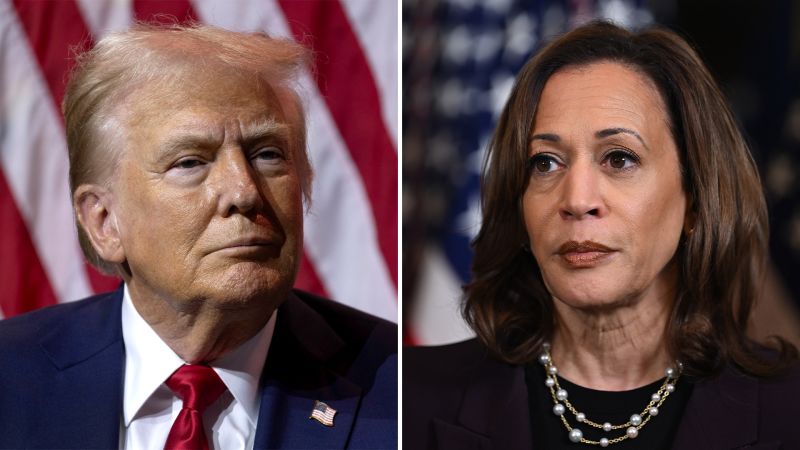Washington
CNN
—
Locked in a tight race for the White House, Vice President Kamala Harris and former President Donald Trump are eager to show voters how they’ll handle the economy if elected.
Both campaigns have a populist bent, but the candidates have differing visions for helping Americans contending with the high living expenses that remain even as the recent spike in inflation has largely passed.
Harris spoke Friday afternoon about the economic proposals she’s rolled out this week, including enhanced tax credits for kids, housing assistance and efforts to stop price gouging. She described her forward-looking agenda as “an opportunity economy,” where Americans are given a real chance to succeed, while saying Trump is only focused on helping the wealthy and big businesses.
Trump held two speeches this week centered on the economy and his policies, but he has yet to release a detailed economic plan. He has repeatedly slammed the Biden-Harris administration for high inflation and has pledged to bring down prices immediately. And he accuses Harris of wanting to institute “communist price controls.”
In reality, a president has few tools to address rising prices unilaterally. It’s the job of the Federal Reserve to set interest rates.
Also, most of their major proposals would require congressional approval – and the candidates have not specified how they’d pay for their costly wish list at a time when the federal debt is swiftly rising, though Harris said she would ask well-off Americans and corporations to pay more.
Here’s what we know so far about Harris’ and Trump’s economic plans:
Eliminate taxes on tips
Both Trump and Harris have called for ending federal taxes on tips – though Trump unveiled the idea first and has blasted his rival for copying him.
The proposal has become one of Trump’s favorite pledges at his campaign rallies.
He first floated the idea in June in Las Vegas, Nevada, a key swing state with many hospitality and service workers, but did not provide any details. Earlier this week, he suggested that he supported eliminating both federal income and payroll taxes on tips – a more financially impactful proposal.
“We’re looking at doing the full bore,” Trump said in an interview with Spectrum News 1 in North Carolina when asked if he supported eliminating both federal income and payroll taxes. Such a measure would require congressional approval.
Asked for clarity afterward, Trump’s national press secretary Karoline Leavitt said she had nothing to add.
About 4 million people worked in tipped occupations in 2023, or about 2.5% of all employment, according to the Budget Lab at Yale University, a policy research center. But more than a third earn too little to owe federal income tax.
Federal payroll taxes fund Social Security and Medicare and total 15.3%, half of which is paid by employers.
Harris last week also promised to end federal income taxes on tips at a rally in Las Vegas. Tips would remain subject to payroll taxes under Harris’ plan.
If both federal income and payroll taxes were eliminated, it would lower revenue by $150 billion to $250 billion over a decade, according to the Committee for a Responsible Federal Budget. Just getting rid of federal income taxes on tips would lead to a loss of about half that size.
End taxes on Social Security benefits
Trump has also offered tax relief to another influential voting bloc – senior citizens. He announced late last month that he wants to end taxes on Social Security benefits.
“To help seniors on fixed incomes who are suffering the ravages of inflation, there will be no tax on Social Security. We’re going to stop it,” he said at a Wednesday rally billed as an economic speech.
Currently, seniors don’t owe taxes on their benefits if they earn less than $25,000 per individual, or $32,000 for married couples, of so-called combined income, which takes into account their adjusted gross income, half their Social Security benefits and nontaxable interest.
Above that threshold, they may have to pay income tax on up to 50% of their benefits, with the revenue going to the Social Security retirement trust fund. Those with combined incomes of at least $34,000 per individual, or $44,000 per couple, could pay income tax on up to an additional 35% of their benefits, with those funds going to Medicare’s hospital insurance trust fund, known as Medicare Part A.
Eliminating the levy on Social Security benefits would reduce taxes by an average of $550, though lower-income households would see little to no benefit next year, according to the Tax Policy Center.
However, the proposal would harm the popular entitlement program, as well as Medicare and the federal budget, according to the Committee for a Responsible Federal Budget. The tax is expected to bring in about $94 billion in revenue this year.
Eliminating the tax would increase federal deficits by between $1.6 trillion and $1.8 trillion through 2035, a committee analysis found. The Social Security retirement trust fund would be depleted more than a year earlier, and Medicare’s hospital insurance trust fund would run dry six years earlier.
Many seniors could ultimately be hurt if Social Security and Medicare’s trust funds run dry sooner and benefits have to be cut.
Add more tariffs
Trump is calling for more tariffs if he returns to the White House. While Harris has not talked about her trade plans specifically, the Biden-Harris administration kept a lot of Trump-era tariffs in place and has increased some of those duties.
During speeches and interviews conducted earlier this spring, Trump called for adding a tariff of at least 10% on all imports from all countries, as well as another tariff upward of 60% on all Chinese imports.
Together, those tariffs could cost a typical middle-income household $1,700 a year, according to an estimate published by the Peterson Institute for International Economics in May.
This week, Trump suggested that the across-the-board tariff could be as high as 20%.
“We’re going to have 10 to 20% tariffs on foreign countries that have been ripping us off for years,” he said during a speech in North Carolina on Wednesday.
Trump has repeatedly claimed that new tariffs will bring back jobs and raise revenue for the country. But economists generally agree that tariffs are a costly way to boost some US manufacturers. In April, Moody’s estimated that even if Trump cushioned the blow from tariffs with tax cuts, his trade proposals would cost the US economy 675,000 jobs, worsen inflation and shrink gross domestic product by 0.6 percentage points.
Plus, tariffs are paid by US importers rather than foreign countries as Trump often suggests. Americans have paid more than $242 billion to date for tariffs that Trump imposed on imported solar panels, steel and aluminum, and Chinese-made goods during his administration, according to US Customs and Border Protection.
In March, Trump also suggested he would put a new 100% tariff on all cars made outside the US if he wins another term.
Most of the Trump-era tariffs remain. In May, the Biden-Harris administration put a plan in place to raise tariffs on certain Chinese-made products, including steel and aluminum, legacy semiconductors and electric vehicles, over the next two years.
Tackle expiring tax cuts
Trump and Harris have differing views on how to handle the expiration of more than $3.4 trillion in individual tax cuts next year.
The former president has said that one of his main goals would be extending the sweeping array of tax cuts in the 2017 Tax Cuts and Jobs Act, one of the signature achievements of his first term. The individual income and estate tax reductions expire at the end of next year.
He has promised more tax cuts for people of all incomes, as well as for businesses, at campaign rallies.
“To get to economic relief to workers and families, we will make additional tax cuts,” he said in Wednesday’s speech. “That’s what gave us the great economy. We’ll make tax cuts additionally. We’ll make them permanent.”
The highest-income households would receive more than 45% of the benefits if the expiring provisions of the TCJA are extended, according to an analysis by the Urban-Brookings Tax Policy Center.
In addition, Trump would like to lower the corporate tax rate to 15% from the 21% set by the 2017 tax cuts – though he acknowledged in an interview last month with Bloomberg Businessweek that reducing it that much would be hard. Most of the corporate tax cuts in the law are permanent.
Harris, on the other hand, said that she will continue President Joe Biden’s pledge not to raise taxes on anyone making under $400,000 a year.
The vice president has also slammed Trump for wanting to extend all of the 2017 tax cuts.
“Donald Trump fights for billionaires and large corporations,” she said Friday. “I will fight to give money back to working and middle-class Americans.”
Enhance tax credits for middle class
Harris unveiled on Friday a plan to cut taxes for the middle-class and lower-income Americans as part of her economic policy rollout. It would offer tax relief for more than 100 million Americans.
Much of the plan revives or extends temporary measures that Biden and congressional Democrats enacted in major packages when the party controlled Congress during the first two years of Biden’s term.
Harris’s proposal would restore the American Rescue Plan’s popular expansion of the child tax credit to as much as $3,600, up from $2,000, and call for it to be made permanent. The enhancement, however, was only in effect in 2021. Biden and Democratic leaders on Capitol Hill were unable to extend it – in part because of the hefty price tag.
The plan would also add a new child tax credit of up to $6,000 for middle class and lower-income families with children in their first year of life. And it would restore the American Rescue Plan’s enhancement of the earned income tax credit, known as the EITC, which increased the maximum credit for workers without dependent children to roughly $1,500. That previous boost was only for 2021.
Plus, the vice president’s package calls for extending the more generous Affordable Care Act premium subsidies that are set to expire at the end of 2025. The enhancement, which was made available through the American Rescue Plan and extended by the Inflation Reduction Act, has helped push sign-ups for Obamacare coverage to record levels.
Harris’ plan does not specify how long these costly provisions would be in effect.
Cut prices
Both Harris and Trump have put a focus on addressing the prices of groceries and other everyday items for Americans.
During Trump’s economic speech on Wednesday, he said he plans to sign an executive order on his first day back in the Oval Office directing all agency heads and Cabinet secretaries to “use every tool and authority at their disposal to defeat inflation and to bring consumer prices rapidly down.”
“You just watch. They’ll come down, and they’ll come down fast,” he said.
One of his strategies to bring down prices, he said, is to “eliminate every single costly job-killing regulation.” But he didn’t provide specifics during his speech.
Trump has also has repeatedly said he will bring down prices by boosting oil and gas production. But prices at the pump in the US are highly dependent on the global oil market and impacted by things out of the president’s control, like Russia’s war on Ukraine or OPEC’s recent decisions to cut oil production. Plus, US oil production has reached record levels under Biden.
“We’re going to drill, baby, drill. That’s going to bring down prices of everything,” he said on Thursday.
Harris has called for a federal ban on price gouging in an effort to target corporations and lower grocery prices, though her campaign has released few details about the proposal.
Some progressives have blamed corporate greed for fueling high prices. The idea is that companies use elevated inflation rates as an excuse to price gouge customers while they bring in record profit margins. Harris argues that big grocery chains have seen their production costs flatten but have kept prices high.
But research released in May by the Federal Reserve Bank of San Francisco found little evidence that price gouging was the main culprit of rising inflation.
While prices remain high, inflation has already slowed after reaching about 9% in 2022. The Consumer Price Index recently fell to below 3%, paving the way for the Federal Reserve to cut rates next month.
Expand affordable housing
Harris announced Friday a three-section plan to address the nation’s lack of affordable housing. Part of the package builds on proposals that Biden has already unveiled.
The vice president’s plan promises to provide up to $25,000 in down-payment support for first-time homebuyers. The down-payment support would apply to working families who have paid rent on time for two years, with more generous support for first-time homebuyers. The plan, which would be implemented during Harris’ first term, according to the campaign, would also provide a $10,000 tax credit for first-time homebuyers, something Biden proposed earlier this year.
According to the Harris campaign, the plan would allow for more than 1 million first-time buyers per year, including first-generation homebuyers, to access the funds.
Harris is also calling for the building of 3 million new housing units. To spur construction, she would provide a first-ever tax incentive for builders who build starter homes sold to first-time buyers. She also would expand an existing tax incentive for building affordable rental housing.
In addition, Harris wants to create a new $40 billion innovation fund to spur innovative housing construction – twice the size of a proposed fund previously announced by the Biden administration. The fund would look to empower local governments, developers and builders to construct more housing that’s affordable and to support new methods of construction financing.
Harris would also seek to repurpose some federal land for affordable housing, similar to proposals floated by Biden and Trump.
The plan also highlights two main proposals that aim to lower rent costs in the US. The first would block landlords from using algorithm-driven price-setting tools to set rents. The second would discourage wealthy investors from buying up properties and marking up rents in bulk by removing tax benefits for investors who buy large numbers of single-family rental homes.
Trump has also touted using federal land to help alleviate the housing shortage – noting it in two campaign events this week.
“We’re going to open up tracts of federal land for housing construction,” he said in a news conference Thursday. “We desperately need housing for people who can’t afford what’s going on now.”
In addition, the Republican National Committee platform says that the party will “promote homeownership with tax incentives and support for first-time buyers and cut unnecessary regulations that raise housing costs,” as well as “reduce mortgage rates by slashing inflation.”
Lower drug costs
Harris also announced a plan Friday that builds on the Biden administration’s efforts to reduce prescription drug costs.
She is calling to expand the current $35 monthly cap on out-of-pocket costs for insulin and the upcoming $2,000 annual limit on out-of-pocket costs for prescription drugs generally to all Americans, not just Medicare enrollees. These caps were put in place for those on Medicare in the Inflation Reduction Act. The $2,000 limit on Medicare Part D drug costs takes effect in January.
(The three major insulin manufacturers in the US offer price caps or savings programs that lower the cost of insulin to $35 for many patients – a move Biden pushed for in his State of the Union address last year.)
Harris’ plan would also accelerate the speed of Medicare’s drug price negotiations so that the costs of more medications come down faster. The Biden administration just announced the results of the first-ever round of negotiations, which is expected to result in $6 billion in savings for Medicare and a $1.5 billion reduction in out-of-pocket costs for seniors when the lower prices take effect in 2026. Medicare gained this historic power through the Inflation Reduction Act.
The vice president would also crack down on drugmakers who block competition and abusive practices by pharmacy benefit managers, who serve as middlemen between drug manufacturers and insurers – though the plan doesn’t specify how she would do this.
In addition, Harris said she would work with states to cancel medical debt for millions of Americans and help them avoid falling behind on health care bills in the future. States and municipalities have used American Rescue Plan funds to cancel $7 billion of medical debt for up to 3 million Americans, according to the campaign. Harris has overseen the Biden administration’s efforts to remove medical debt from credit reports.
CNN’s Ella Nilsen and Samantha Delouya contributed to this report.
This headline and story have been updated with additional information.








